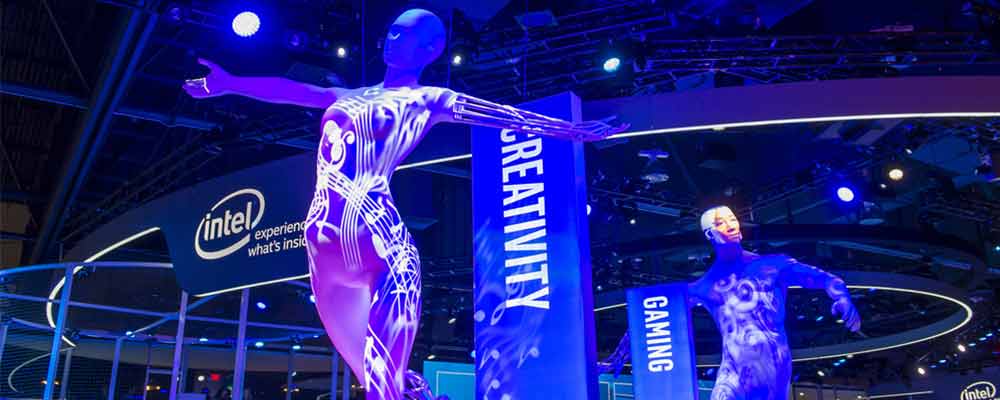The earliest memory that I have of Intel Corp. (Nasdaq: INTC) was, as a 7-year-old kid, seeing this commercial, which advertised its Pentium 4 processor.
I’m not really sure why that one stuck out. It might have been the aliens. Or maybe the shiny Pentium 4 chip inside the computer.
That shiny chip, at the time, was the greatest thing that you could get for a PC, and Intel was in the midst of huge breakthroughs in the internet and personal computing areas.
As the leading chipmaker in the tech bubble, Intel stock was on top of its world, seeing its price appreciate over 1,000% from March 1996 to March 2000, before the burst of the dot-com bubble.
Since then, while maintaining its status as a leading tech company in terms of size, it hasn’t been known as much for cutting-edge technology. Instead, it has been seen as a boring, mature tech company that is past its prime.
But what investors are starting to realize is the impressive growth that Intel is seeing in other facets of its business — specifically, data storage, the Internet of Things (IoT), artificial intelligence (AI) and virtual reality (VR).
Connecting the World
There are two primary areas that Intel is breaking into with data storage: memory capacity and speed.
Its 3-D NAND drive provides a way for companies and data centers to store data safely with less hardware. And its Optane technology creates a way for the data to be easily accessible, reducing the speed that it takes to retrieve it.
Without getting too technical, there is exponentially rising demand for technology like this, and Intel is a trustworthy company that customers will look to first.
In fact, Intel has the top market share in the SSD (solid-state drive) market, over 40%, where 3-D NAND is the new hot product. This industry is expected to grow at almost 15% per year and be a $33.6 billion market in 2021.
And in the IoT industry, product development has increased so rapidly that it’s created an entire new market of products.
While you may not think of Intel as an IoT company, it is launching a very interesting approach that can be used behind the scenes to make the switch to an IoT-centric world easier to manage.
Intel’s Secure Device Onboard program will automatically configure IoT-enabled devices to the network. Essentially, they “see” each other, recognize that they’re IoT devices and connect over the network.
Not the Intel You’re Used To
Intel’s processors have also been used to gather and process data on AI. An example of this is its collaboration with a startup personal finance company called Clinc, whose app helps people with things like personal finance and banking.
The way that the program “learns” trends and typical behavior of human spending that is made possible by Intel’s Xeon processor. With all of the data gathered in this app, the program will “learn” how people typically use their money and offer solutions to help them manage it more efficiently.
Another huge AI program that Intel has been using is Saffron.
Saffron was an AI startup that Intel quickly bought in late 2015 as one of its first moves into the technology. Intel has turned Saffron into its own version of IBM’s Watson and has used it for a ton of projects.
One of the more impressive and most practical uses that Intel is working on right now with Saffron is medical diagnosis.
Obviously, misdiagnosing medical patients can have horrible consequences. And there are about 12 million people misdiagnosed in the U.S. every year despite the country having some of the most advanced medicine in the world.
Saffron was recently used to differentiate diagnoses between two forms of heart failure that appear similar but require very different treatments. A skilled doctor typically has a 75% rate of diagnosing these diseases correctly, and most doctors are closer to 50%.
But after going through the data, Saffron achieved a 90% accuracy rate by scanning over 10,000 signals per heartbeat.
That’s not the “boring computer chip” Intel that most people think of.
An Unforgettable Experience
Intel also has been developing a presence in VR.
In fact, this year, Intel has installed extremely powerful cameras all over the Olympic sites in Pyeongchang, South Korea, that can stream VR data directly to your phone using their high-power processing chips.
This platform supports a variety of Samsung phones and can be used with the Google Cardboard VR set. So instead of looking at your phone, it will seem like you’re right there in the middle of the action at the Olympics. If you have an eligible phone, the app is free, and Google Carboard costs about $15, so it’s a fun experience that’s really inexpensive.
Rejuvenated Growth for Intel Stock
Despite all of this action taken by Intel to emerge as a cutting-edge technology powerhouse, Wall Street analysts still expect only 3.5% annual revenue growth for the next three years.
However, look at these growth rates Intel has seen in the past year:
- Its data storage segment has grown 20%.
- Its IoT segment has grown 21%.
- And its semiconductor segment has grown 35%.
These three segments now make up over 41% of Intel’s total business, compared to 35% a year ago.
These are sure signs of a company in the process of redefining itself from a mature company to a company with rejuvenated growth.
I believe that with these growing segments, Intel stock can easily see a 50% upside over the next couple of years.
Keep in mind that the stock was worth $75 per share at the height of the tech bubble and has yet to top that. I believe that can easily happen in two years.
Regards,

Ian Dyer
Internal Analyst, Banyan Hill Publishing
Editor’s Note: After 25 years on Wall Street managing billions of dollars, Paul has the keen ability to understand what makes a company great. That’s the reason he’s been able to spot home-run stocks year after year, even when the media and the market are completely against them. And in Paul’s True Momentum research service, his in-the-trenches experience is geared toward one crystal-clear goal: helping you grow your wealth 300% in the next 12 months. To find out how easy it is to make incredible gains by using Paul’s recommendations, simply click here now.




